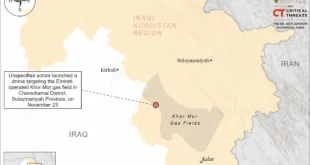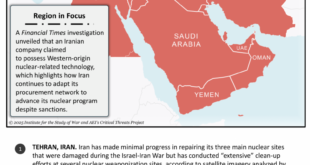
Facebook and YouTube say they have scrubbed tens of thousands of violent extremists posts. But we found 105 from the most dangerous preachers of jihadist terror.
In 2006, Ibrahim Suleiman al-Rubaish was repatriated to Saudi Arabia from Guantanamo Bay after he’d served more than five years as an enemy combatant for training with al Qaeda, and fighting alongside the Taliban in Afghanistan against the United States. Released as part of the Obama administration’s plans to shutter the offshore prison, Rubaish was admitted to Riyadh’s rather lackluster “deradicalization” program.
Then, sometime in 2009, he escaped the program and Saudi Arabia with 11 other jihadists. They all turned up in Yemen and Rubaish soon emerged as the mufti, or Islamic jurist, for al Qaeda in the Arabian Peninsula (AQAP) where he spent the next six years appearing in propaganda videos for the group’s media outlet Al-Malahem, as well as releasing a number of fatwas and articles for other al Qaeda outlets including the English-language Inspire magazine.
Rubaish was killed in a U.S. drone strike in Yemen in 2015. But his ideas and legacy live on through his sermons and speeches, still hosted on Facebook and YouTube.
Rubaish is joined in digital preservation by other leading lights in jihadist proselytization and virtual recruitment such as Abu Mus’ab al-Suri, the strategist behind the expansion of al Qaeda into Yemen, who helped invent what’s now commonly known as the “lone-wolf” terror attack; Nasir al-Wuhayshi, the leader of AQAP and the second-in command to Ayman al-Zawahiri, al Qaeda’s global head; and Anwar al-Awlaki, the main cleric for AQAP who is considered by counterterrorism experts to be, even from beyond the grave, one of the primary drivers of those lone-wolf attacks.
Taken together, Rubaish, Suri, Wuhayshi and Awlaki can still be found in 105 videos on both social media platforms, despite corporate avowals that this stuff was fast becoming a thing of the past. Yet we identified the videos through simple searches in Arabic using only the names of these prominent jihadists.
At a minimum, this demonstrates that Silicon Valley’s much-touted counter-extremism policies—now being applied to fascist and neo-Nazi content—aren’t using rigorous enough standards in classifying terrorist indoctrination materials; or they’ve simply reached the limits of what their algorithms or human monitors can handle in languages other than English. Or both.
The videos we uncovered are primarily speeches given by Rubaish, Suri, Wuhayshi and Awlaki over the last several years, all devoted to jihadist strategy and theology, spread through individual users as well as public pages and groups. All told, the 105 videos have garnered more than 190,000 views. Of the al Qaeda quartet only one still has a dedicated Facebook page with 46 videos uploaded for public viewing.
Contacted yesterday, Facebook said it was looking into the videos that we highlighted on its platform; YouTube did not respond to our queries in time for publication.
Suri’s lessons in jihad, many of them recorded in the early 2000s, were focused on the key points from his playbook, Global Islamic Resistance Call. They total some five hours and 45 minutes of footage on the virtual shrine to him still visible on Mark Zuckerberg’s software.
The most-watched video is his half-hour history on the invasions and subsequent injustices that the Muslim world has faced; it seems to have been recorded somewhere in Europe, as he refers to the “Christian world here in Europe.” Suri has Spanish citizenship and between 1994 and 1996 he lived in the London suburb of Neasden. Following the London bombings of 2005, he released a statement praising the selection of mass transit as a major, legitimate soft target.
He is arguably al Qaeda’s foremost dialectician; Suri sought to encourage anyone with the will and means to commits acts of terror to do so in order to precipitate a backlash against Muslims in Europe, pushing them into the arms of the jihadists. This strategy has indeed succeeded, perhaps more than Suri ever anticipated.
(After being captured by Pakistan authorities, Suri was supposedly the “ghost prisoner” in a secret U.S. detention facility before being rendered to Syria and was then rumored to have been released from prison by the Assad regime sometime in 2012. His whereabouts remain unknown.)
Facebook claimed last year to have removed 99 percent of “terror content” before it was reported by third parties. In the first three months of 2019, YouTube said it removed 89,968 videos that violated its violent extremism policy.
One of the most prevalent results of this cull is the scraping of Awlaki content in both Arabic and English. The name of the AQAP cleric used to yield 40,000 hits on YouTube. Today, both Facebook and YouTube have managed to eliminate most of them—but not all. We identified seven Awlaki speeches across both platforms, in Arabic. One, a gauzy depiction of the afterlife, which also glorifies Awlaki’s time on earth and his demise by American drone strike in Yemen in 2011, has been viewed 4,400 times since January.
Born in the New Mexico and once platformed by U.S. authorities as an exponent of moderate Islam, Awlaki’s message is essentially that true Islam is incapable of being practiced or espoused in the U.S. and thus this serves as a justification for holy war against the country and its interests. The video has been shared 23 times across the platform; the comments are wholly supportive. (Awlaki’s also proved impossible to suppress in English. In the past two years, a number of YouTube accounts have been posting his lectures in his native tongue via two primary playlists, collectively composed of 174 videos. These playlists even highlight their banned status on YouTube to excite further interest, which seems to have worked: collectively they’ve been viewed 300,000 times.)
Multimedia has traditionally been a boom business for jihadists for an obvious reason: it’s an incredibly easy way for non-state actors to cross state boundaries in milliseconds and radicalize and recruit new followers without even meeting them.
Awlaki’s speeches were instrumental in coaxing Umar Farouk Abdulmutallab, who visited the cleric in Yemen while still an engineering student at University College London, to try to detonate a bomb sewn into his underwear while onboard a plane to Detroit in 2009. Suri was linked to the 2004 Madrid train bombers, and his work has inspired those in ISIS to call for “lone wolf” attacks in the West. Rubaish agitated for killing anyone who insults the Prophet. AQAP later took responsibility for operationalizing the Charlie Hebdo massacre in Paris.
And that’s why Facebook and YouTube have submitted to government pressure to scrub their sites of radical content. Yet it’s evidently easier to play Whac-A-Mole in English than in Arabic, the lingua franca of jihad. If social media companies are to make good on their counter-extremism policy, they’ll need a more comprehensive—and polyglot—approach.
 Eurasia Press & News
Eurasia Press & News


